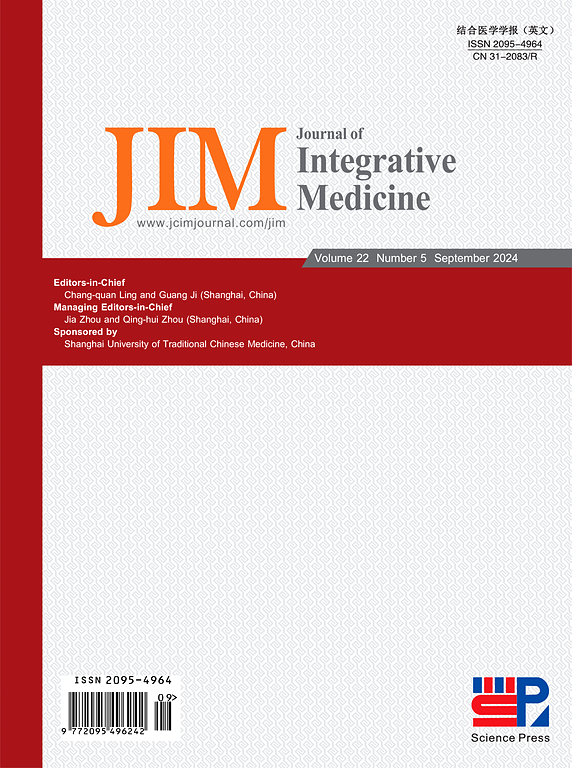Realgar-indigo naturalis formula for the treatment of patients with relapsed and arsenic trioxide-resistant acute promyelocytic leukemia: A case series
IF 4
2区 医学
Q1 INTEGRATIVE & COMPLEMENTARY MEDICINE
引用次数: 0
Abstract
Introduction
There is currently no standard treatment for relapsed and arsenic trioxide (ATO)-resistant acute promyelocytic leukemia (APL). Here, we report a case series of realgar-indigo naturalis formula (RIF) for the successful treatment of patients with relapsed and ATO-resistant APL.
Case presentation
Two patients in the first relapse and one in the second relapse failed to achieve hematologic complete remission (HCR) when reinduced by ATO; the other five patients progressed to relapse during ATO-based regimens for post-remission therapy. These eight patients received RIF in three doses per day totaling 130 mg/kg (≤ 30 pills) as induction therapy and achieved HCR at a median time of 46.5 days. They received 5 years of post-remission therapy, which consisted of combined chemotherapy followed by RIF. During this period, the patients did not experience renal dysfunction or QT interval prolongation. At the last follow-up, three patients survived without relapse, two patients survived with a second or third relapse and third or fourth remission, and the other three patients relapsed for a third or fourth time and died. The 5-year overall survival and event-free survival rates were 75.0% (95% confidence interval [CI]: 31.5–93.1) and 37.5% (95% CI: 5.6–71.7), respectively.
Conclusion
RIF for induction therapy and RIF combined with chemotherapy for post-remission therapy may represent an effective and safe protocol for the treatment of patients with relapsed and ATO-resistant APL.
Please cite this article as: Fang YG, Huang SL, Chen NN. Realgar-indigo naturalis formula for the treatment of patients with relapsed and arsenic trioxide-resistant acute promyelocytic leukemia: a case series. J Integr Med. 2024; 22(5): 614–620.
治疗复发和对三氧化二砷耐药的急性早幼粒细胞白血病患者的雄黄-靛蓝配方:病例系列。
简介:目前还没有治疗复发和对三氧化二砷(ATO)耐药的急性早幼粒细胞白血病(APL)的标准疗法。在此,我们报告了一组使用雄黄-靛蓝天然配方(RIF)成功治疗复发和对三氧化二砷耐药的急性早幼粒细胞白血病患者的病例:第一次复发的两名患者和第二次复发的一名患者在接受ATO治疗后未能达到血液学完全缓解(HCR);另外五名患者在接受ATO治疗后复发。这8名患者接受了RIF诱导治疗,每天3次,总剂量为130毫克/千克(≤30粒),中位时间为46.5天,获得了HCR。他们接受了为期 5 年的缓解后治疗,包括联合化疗和 RIF。在此期间,患者未出现肾功能障碍或 QT 间期延长。在最后一次随访中,3 名患者存活且未复发,2 名患者存活且第二次或第三次复发,第三次或第四次缓解,另外 3 名患者第三次或第四次复发并死亡。5年总生存率和无事件生存率分别为75.0%(95%置信区间[CI]:31.5-93.1)和37.5%(95%置信区间:5.6-71.7):结论:RIF用于诱导治疗,RIF联合化疗用于缓解后治疗,可能是治疗复发和ATO耐药APL患者的一种有效而安全的方案。本文引用如前Fang YG, Huang SL, Chen NN.治疗复发且对三氧化二砷耐药的急性早幼粒细胞白血病患者的雄黄-靛蓝配方:一个病例系列。J Integr Med.2024; Epub ahead of print.
本文章由计算机程序翻译,如有差异,请以英文原文为准。
求助全文
约1分钟内获得全文
求助全文
来源期刊

Journal of Integrative Medicine-Jim
Medicine-Complementary and Alternative Medicine
CiteScore
9.20
自引率
4.20%
发文量
3319
期刊介绍:
The predecessor of JIM is the Journal of Chinese Integrative Medicine (Zhong Xi Yi Jie He Xue Bao). With this new, English-language publication, we are committed to make JIM an international platform for publishing high-quality papers on complementary and alternative medicine (CAM) and an open forum in which the different professions and international scholarly communities can exchange views, share research and their clinical experience, discuss CAM education, and confer about issues and problems in our various disciplines and in CAM as a whole in order to promote integrative medicine.
JIM is indexed/abstracted in: MEDLINE/PubMed, ScienceDirect, Emerging Sources Citation Index (ESCI), Scopus, Embase, Chemical Abstracts (CA), CAB Abstracts, EBSCO, WPRIM, JST China, Chinese Science Citation Database (CSCD), and China National Knowledge Infrastructure (CNKI).
JIM Editorial Office uses ThomsonReuters ScholarOne Manuscripts as submitting and review system (submission link: http://mc03.manuscriptcentral.com/jcim-en).
JIM is published bimonthly. Manuscripts submitted to JIM should be written in English. Article types include but are not limited to randomized controlled and pragmatic trials, translational and patient-centered effectiveness outcome studies, case series and reports, clinical trial protocols, preclinical and basic science studies, systematic reviews and meta-analyses, papers on methodology and CAM history or education, conference proceedings, editorials, commentaries, short communications, book reviews, and letters to the editor.
Our purpose is to publish a prestigious international journal for studies in integrative medicine. To achieve this aim, we seek to publish high-quality papers on any aspects of integrative medicine, such as acupuncture and traditional Chinese medicine, Ayurveda medicine, herbal medicine, homeopathy, nutrition, chiropractic, mind-body medicine, taichi, qigong, meditation, and any other modalities of CAM; our commitment to international scope ensures that research and progress from all regions of the world are widely covered. These ensure that articles published in JIM have the maximum exposure to the international scholarly community.
JIM can help its authors let their papers reach the widest possible range of readers, and let all those who share an interest in their research field be concerned with their study.
 求助内容:
求助内容: 应助结果提醒方式:
应助结果提醒方式:


